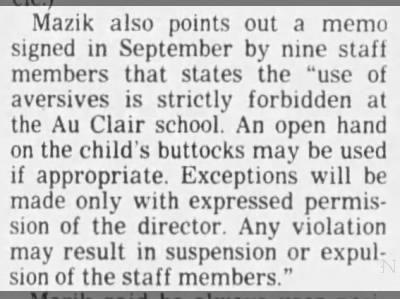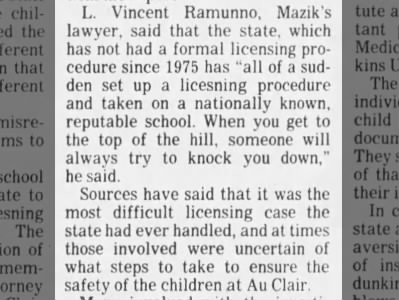Mazik immediately assembled his resources calling on parents to come to the school's defense - and they would. He acquired the legal services of Vincent Rammuno, brother-in-law of friend and business partner Joe Capano. The state's findings? He called them unprofessional. The report? "Scurrilous and the most unprofessional work I have ever seen." The accusations? An assault, the result of his mastermind his ex-wife as a part of their contentious divorce. The sources? Disgruntled current and former employees. "Poppycock" he called it.
For each allegation, Mazik had an explanation:
*Responses from the July 21, 1979 story on Au Clair, the first in a five day series that delved into the school and its operations.
1. The Use of Punitive Aversive Techniques: In 1979, the use of aversives was an ongoing controversy. Mazik fell into the old school camp that believe there were times when such punishments were necessary.
2. Manipulation of the school's computer and video recording system: Mazik claimed to have never misrepresented the schools programs to parents or the public.
3. The fabled Master's degree: Mazik denied portraying himself as every having one, although that didn't keep him from signing internal documents with MA after his name. He claimed to have represented himself as having education similar to a Master.
4. The reports of child abuse in 1978: The first spoke for itself. No charges had been filed. For the November allegation, Mazik had a reasonable explanation. He denied using a belt to punish the student "whom he described as self destructive." Mazik needed to remove him from his top bunk in order to "calm him before he hurt himself." He also claimed that many of the procedures being deemed "aversives" in the report were actually "restraints" used to protect a child from himself.
5. The findings that Mazik failed to comply with regulations over staffing: Despite allegations by former staffers that Mazik was difficult to reach when needed, that he provided little or no supervision, and that the 3rd shift was drastically understaffed, Mazik was unapologetic for what he called "poppycock" and explained that a supervisor was onsite for all shifts. He also claimed that all staff members knew how to reach him.
6. Mazik was unconcerned about the allegations regarding meals as he stated that all children received adequate meals.
7. He blasted the state report for its allegations of over-crowding and explained away the room that housed four beds and six students. He claimed that there were never more than five students in that room that was infrequently used at night for the more destructive children.
8. As for the state's decision to withhold a new license:
Had the state lacked a licensing procedure from 1975 to 1979? It was an interesting and enlightening turn of events. Perhaps there was some poppycock in play...
















